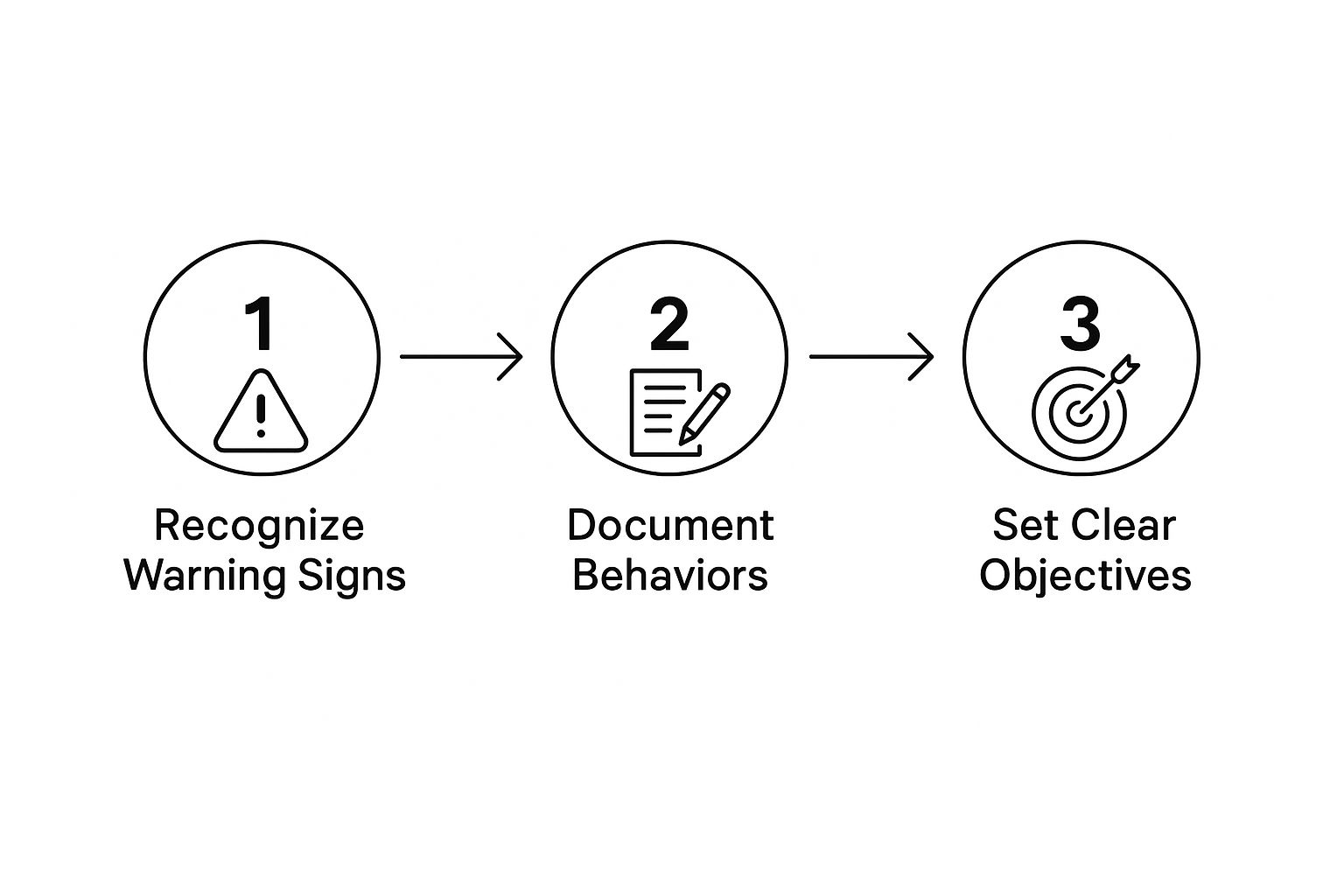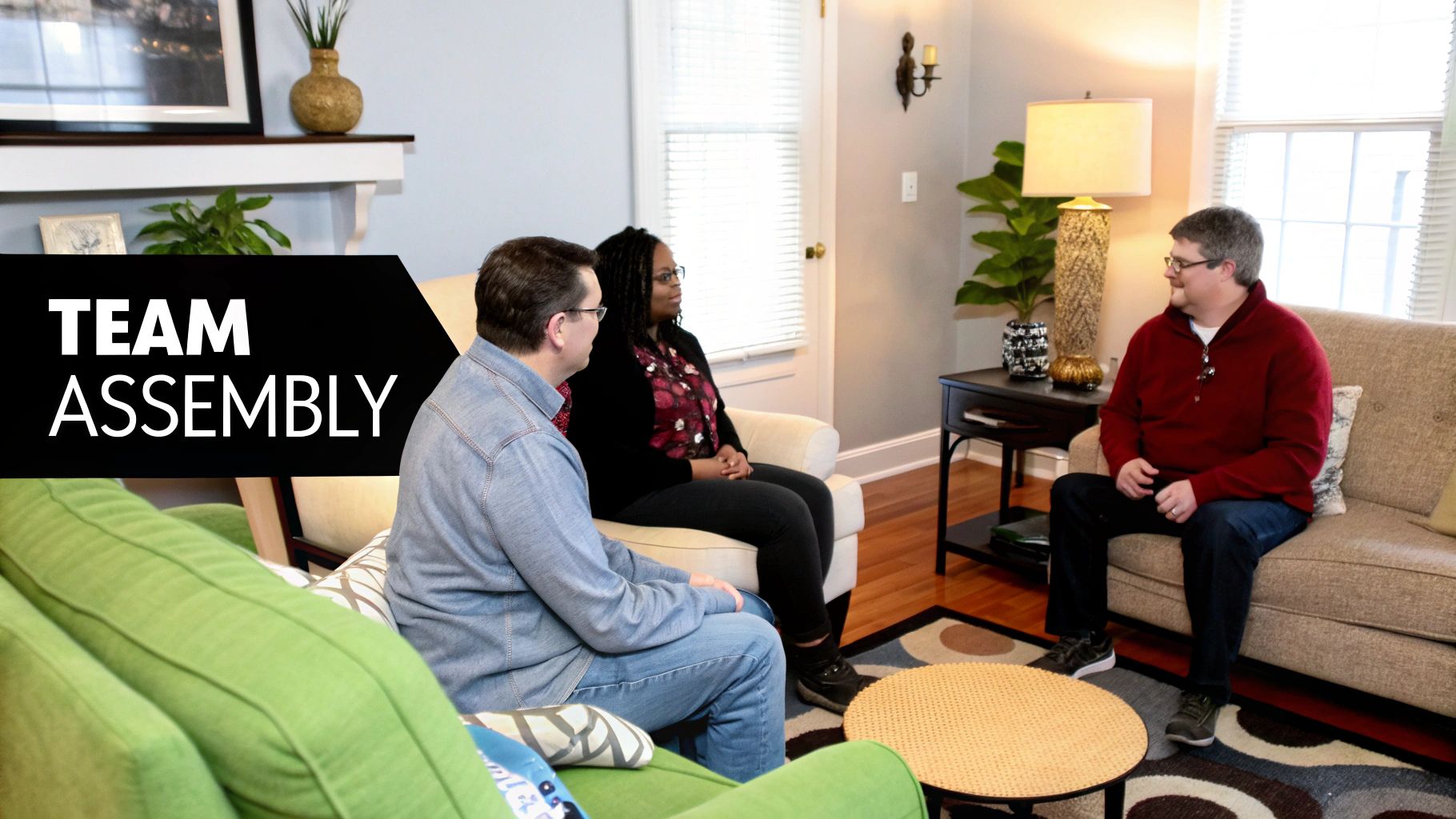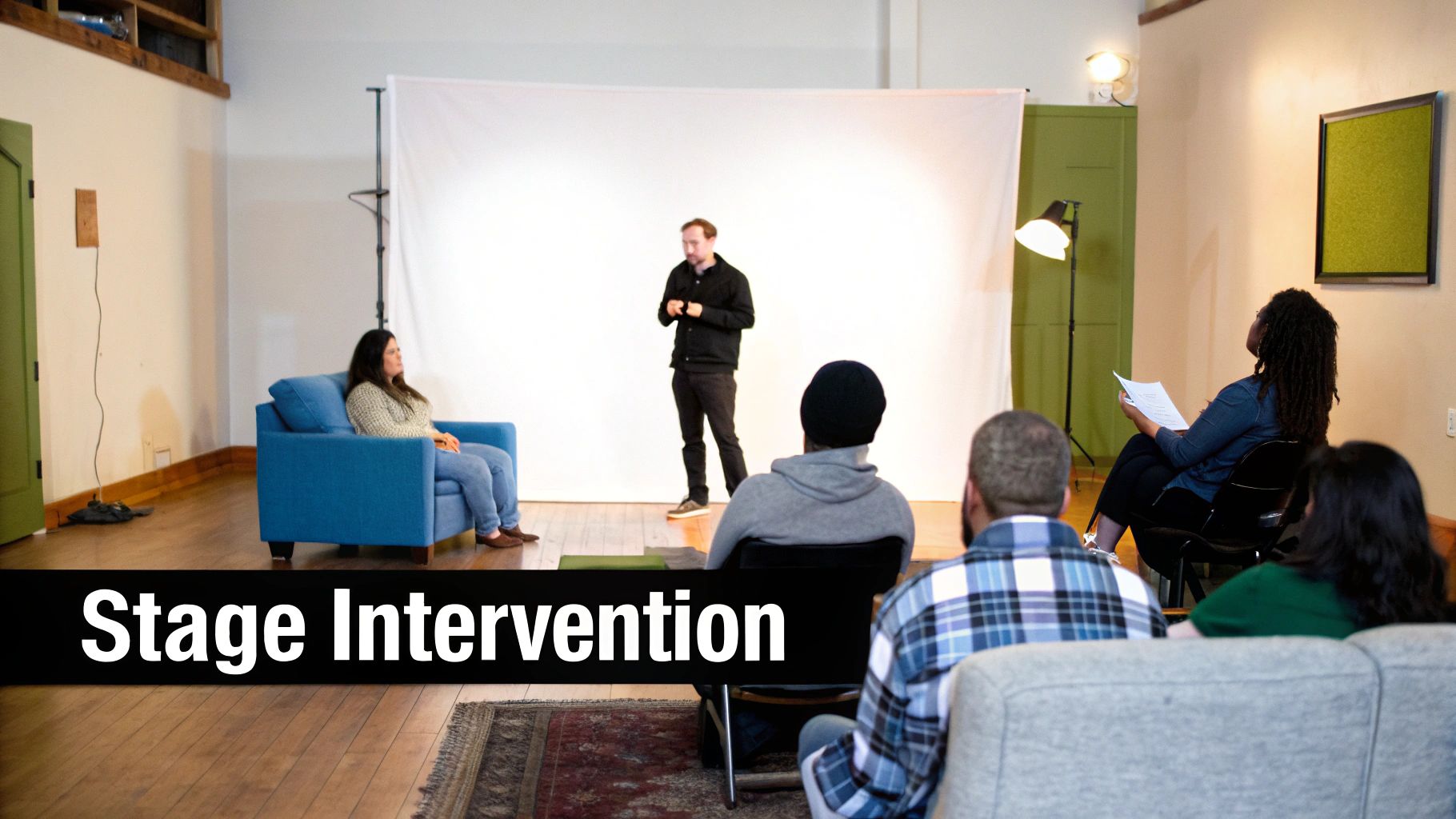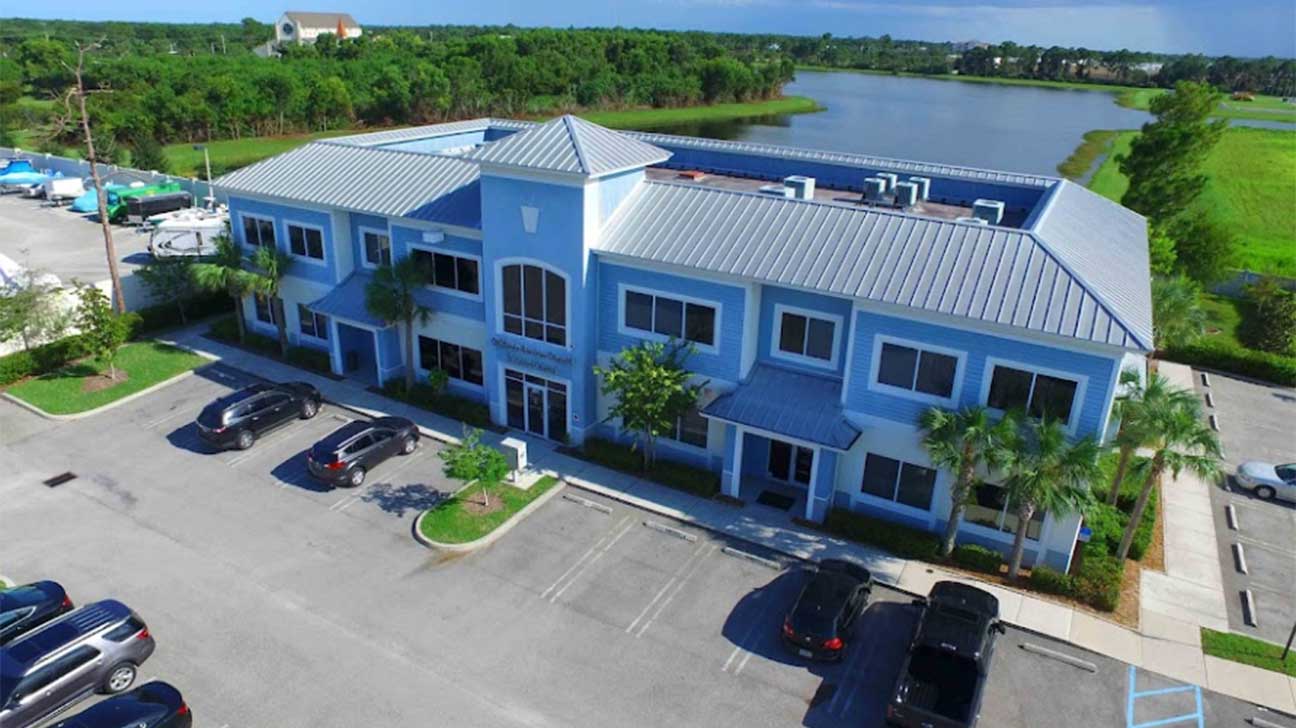
Watching someone you care about struggle with addiction is a deeply painful and often frustrating experience. You’ve probably had countless conversations, pleaded with them, and maybe even argued, only to feel like you’re hitting a brick wall. This is a common and heartbreaking cycle.
The reason those spontaneous pleas often fall short is that they’re usually driven by emotion in the heat of the moment. They lack a unified message and, most importantly, a clear, actionable plan for what comes next.
An intervention, on the other hand, is something entirely different. It’s a carefully choreographed process where family and friends come together to present a loving, united front. The goal isn’t to confront or shame but to cut through the denial with compassion and offer a pre-arranged, immediate path to getting help. It’s about replacing reactive arguments with a proactive, structured act of love.
From Pleading to a Plan: Why a Structured Intervention Works
The real power of an intervention lies in its preparation. It fundamentally shifts the dynamic from a chaotic cycle of emotional outbursts to a single, focused, and calm conversation. It’s not about winning an argument or delivering an ultimatum out of anger; it’s a meticulously organized effort designed to open the door to recovery.
The strength comes from everyone being on the same page, with the same loving goal in mind.
The Groundwork is Everything
Before you even think about who will be in the room, you have to lay the foundation. This starts with acknowledging the severity of the problem and gathering specific, fact-based examples of how the addiction has impacted everyone involved. You’re moving from “You’re always drinking!” to “Last Tuesday, when you were drinking, you missed your daughter’s soccer game, and she was devastated.”
This initial prep work is crucial.

As you can see, the process begins long before the actual meeting. It’s about building a case for change that is rooted in real-life events, not just emotional reactions. This ensures the conversation stays grounded and productive.
Shifting Your Approach
The core difference between a desperate plea and a successful intervention is the plan. Instead of simply begging them to stop, you’re building a structured event. This involves several key steps:
- Forming the Team: You’ll want to assemble a small group of people who genuinely care for the individual and can remain calm and supportive.
- Detailed Scripting: This isn’t a free-for-all. You need to decide on a time, a neutral location, and exactly what each person will say.
- Writing Impact Statements: Each team member writes down how the person’s substance use has personally affected them. These aren’t blame letters; they are “I” statements based on love and concern.
- Rehearsing the Conversation: Practice is essential. Running through the intervention beforehand helps everyone stay on message and manage their own emotions when the time comes.
- Securing a Treatment Spot: This is non-negotiable. You must have a treatment facility lined up and ready to admit your loved one immediately. The bags should be packed.
This structured approach makes a world of difference. While it’s estimated that only about 10% of people with a substance use disorder will seek help on their own, a professionally guided or well-planned intervention can successfully get 70-80% of individuals to accept treatment.
To get a successful intervention off the ground, it’s critical to understand the key stages involved. The process can be broken down into distinct phases, each with a clear purpose that builds toward the ultimate goal: getting your loved one to accept help.
Core Phases of an Effective Intervention
| Phase | Objective |
|---|---|
| Initial Consultation | Seek professional guidance from an interventionist or therapist to determine if an intervention is the right approach. |
| Team Formation | Assemble a small, committed group of close family and friends who can remain supportive and calm. |
| Planning & Education | Educate the team on addiction, set firm boundaries, and write fact-based impact letters. |
| Rehearsal | Practice the entire intervention to ensure a smooth, unified, and calm delivery on the day. |
| The Intervention | Hold the meeting, present the letters, and offer the pre-arranged treatment plan with clear consequences if refused. |
| Follow-Up | Support the loved one through treatment and recovery, and ensure the family continues with its own counseling and support. |
Each of these phases is a building block. Skipping one can compromise the entire effort, which is why taking the time to plan meticulously is so vital for a positive outcome.
“The goal isn’t to win an argument; it’s to offer a lifeline. Every element, from who is in the room to the specific words used, is intentionally chosen to make it easier for your loved one to say “yes” to help.”
By focusing on these deliberate, thoughtful steps, you create the best possible chance for a breakthrough. For a more comprehensive look at the specific actions within each phase, our guide on holding an intervention offers valuable, in-depth details to walk you through the process.
Building Your Intervention Team

The real power of an intervention comes from a unified, compassionate voice. So, your very first task is to assemble the right team. This isn’t about gathering a crowd; it’s about carefully choosing a small, dedicated group of people who genuinely love the person you’re trying to help.
Think small and intimate. The sweet spot is usually between three and six people. This size is large enough to show a strong, united front but small enough to feel supportive and not like an ambush. Every single person on this team needs to be able to stay calm, speak from the heart, and stick to the plan—including the consequences you’ll all agree on beforehand.
Call Now – Your Journey to Recovery Begins Today!

Take the first step towards a healthier life! Call now to connect with our compassionate team and start your recovery journey today. Your path to healing awaits!
Our recovery specialists are available 24/7 to provide support, and all calls are confidential and free. Reach out anytime – we’re here to help!
Who Should Be on the Team
Choosing the participants is a delicate balance. You’re looking for people your loved one trusts and respects, people who have seen the impact of the addiction up close. The goal is to surround them with undeniable love and concern.
Ideal candidates often include:
- Parents and Spouses: Their connection is often the deepest, and they can speak directly to how the addiction has shaken the core family unit.
- Adult Siblings or Children: They bring a different but equally important perspective, whether as a peer or someone who has looked up to your loved one.
- A Trusted Best Friend: This person can talk about the impact on friendships and their social life, showing that the problem has spread beyond the family circle.
- A Respected Elder or Mentor: A grandparent, aunt, uncle, or even a clergy member can bring a voice of wisdom that might cut through the denial.
“The single most important quality for any team member is their ability to express deep concern without anger or judgment. The entire feeling of the intervention has to be one of support, not a trial.”
Who to Leave Out
Just as important as who you invite is who you decide not to invite. Protecting the focus and emotional safety of the intervention means being selective. For example, a sibling who has their own unaddressed substance abuse problem is not a good choice. Their presence would be a distraction and frankly, hypocritical.
You should also leave out anyone who has enabled the behavior in the past or has a volatile, drama-filled relationship with your loved one. Their presence could easily blow up the entire meeting. And, critically, anyone who can’t fully commit to the pre-planned boundaries and consequences has to be excluded. Unity is everything.
If you’re struggling with these tricky family dynamics, our article on helping a loved one with addiction has some really practical strategies.
The Value of a Professional Interventionist
Let’s be direct: hiring a professional interventionist is probably the single best thing you can do to ensure the intervention is successful. Yes, it costs money, but their value is hard to overstate. An interventionist acts as a neutral, experienced guide who knows how to manage high-stakes emotions, de-escalate conflict, and keep the meeting on track.
Think of them as a director for a very difficult, emotional play. They help your team prepare what to say, rehearse the meeting, and anticipate your loved one’s likely reactions—from rage and denial to shame and acceptance. Their calm, authoritative presence can stop the intervention from spiraling into another chaotic family argument, making it a much safer and more effective process for everyone.
Getting Ready: The Art of Planning and Rehearsal

When an intervention works, it’s almost always because of what happened before everyone sat down in the same room. This is where you lay the groundwork for a conversation that feels calm, loving, and firm. Think of it less as preparing for a confrontation and more as choreographing a moment of profound clarity.
Your first practical step is logistics. You need to pick a time and place. This isn’t random. Try to find a time when your loved one is most likely to be sober and not rushed—often, first thing in the morning works far better than at the end of a long day. The setting should feel safe and neutral. A family member’s home is a good choice; your loved one’s own space is not, as it can make them feel trapped and defensive.
Writing Letters That Break Through
The real power of an intervention comes from the impact letters. These aren’t just lists of grievances or angry rants. They are your chance to communicate love and deep concern, grounded in reality. Each person on the team needs to write one, and they all have a similar purpose: to show, not just tell, the effect the addiction is having.
The key is to ditch blaming language like, “You always ruin things,” and instead use “I” statements that reflect your own experience. It’s a subtle but powerful shift from accusation to connection.
Here’s a simple framework for your letter:
- Start with love. Remind them how much they mean to you, setting a foundation of care.
- Share a specific memory. Talk about a single, factual event tied to their substance use. For example, “I remember how scared I was when I got the call that you were in the hospital last month.”
- Explain how it felt. Connect that event to your emotions. “I felt completely helpless,” or “My heart broke watching you go through that.”
- Make the offer. This is where you clearly state your support for their recovery and introduce the treatment plan you’ve already arranged.
“These letters are the heart of the intervention. They take all the unspoken worry and fear and turn it into tangible, undeniable stories. For someone trapped in denial, hearing these personal accounts is often the very thing that helps them see the truth.”
Why You Can’t Skip the Rehearsal
After the letters are written, the entire team must get together and rehearse. I can’t stress this enough—it is the single most important step you can take to ensure the intervention goes smoothly. A full run-through helps everyone get on the same page and prepares you for the intense emotions of the actual day.
Here’s what a rehearsal should cover:
- Read your letters out loud. This is a gut check. It helps you find the right words and lets you experience the emotions in a safe space, so you’re not overwhelmed during the real thing.
- Game-plan the reactions. What will you do if your loved one gets angry? Bursts into tears? Tries to walk out? Role-playing these scenarios helps the team practice responding calmly, without getting drawn into an argument.
- Lock in the logistics. Decide who will speak when and what the immediate next steps are, whether they say yes or no. Knowing exactly what to do next is crucial for maintaining control. For a deeper dive, you can learn more about how to get a loved one into rehab.
Rehearsing builds a unified, confident team. This isn’t just a new idea; structured family meetings have been used since the 1960s. Today, we know that family-led interventions have a 62% success rate in getting someone into treatment. When you bring in a professional, that number can climb to over 75%. It’s proof that a well-planned, structured approach truly works.
Call Now – Your Journey to Recovery Begins Today!

Take the first step towards a healthier life! Call now to connect with our compassionate team and start your recovery journey today. Your path to healing awaits!
Our recovery specialists are available 24/7 to provide support, and all calls are confidential and free. Reach out anytime – we’re here to help!
Leading the Intervention Meeting with Compassion

The moment is finally here. All the emotional phone calls, the late-night writing, and the nervous rehearsals have brought you to this very room. The air will feel heavy, thick with a mix of fear and hope, but your careful planning is your anchor. Remember, this isn’t a trial. It’s a powerful, unified expression of love and concern.
Have your loved one walk into the quiet, private space where the rest of the team is already gathered. Those first few moments are so important. Keep your greetings brief, calm, and gentle. The person you’ve designated as the leader—ideally a professional interventionist—should then calmly explain why everyone has come together, immediately framing the meeting with love.
The Flow of the Meeting
Once the purpose is clear, it’s time for each person to share their letter. This part of the meeting needs to be structured and free of interruptions. One person speaks at a time, reading their heartfelt, fact-based letter without resorting to blame or anger. Everyone else listens in silence, providing quiet, steady support.
This is where all that rehearsal really pays off. Your loved one might become defensive, angry, or try to argue. It’s natural. The group’s job is to stick to the plan: do not engage in a debate. Simply listen to what they have to say, acknowledge their feelings, and then calmly have the next person begin reading their letter.
The goal is to weave together an undeniable narrative of how their addiction has impacted the people who care about them most. Hearing these stories, one after another, is a powerful experience that can begin to gently dismantle the wall of denial.
Presenting the Lifeline
After the last letter has been read, the meeting takes a crucial turn. This is when you present the pre-arranged treatment plan. It’s vital to frame this not as a punishment or an ultimatum, but as a tangible, immediate lifeline you are offering.
One person should explain the solution you’ve put in place. For instance: “We love you so much, and we can’t stand to watch you hurt anymore. We’ve found a wonderful treatment center that can help. A spot is reserved for you, your bag is packed, and we are ready to drive you there right now.”
“The whole point is to remove every single obstacle. You want to make “yes” the easiest possible answer. By handling the logistics—from facility admission to transportation—you’ve cleared the path for them to accept help.”
Navigating Difficult Reactions
Be ready for a whole spectrum of emotional responses. The success of the intervention often hinges on your ability to manage these reactions with grace and composure.
Here’s what you might encounter and how to respond:
- Denial or Anger: If they fire back with, “This is ridiculous, I don’t have a problem,” resist the urge to argue. A calm response like, “We hear you, but this is what we’ve experienced and how it has made us feel,” gently brings the focus back to your shared reality.
- Bargaining or Pleading: They may try to negotiate a lesser consequence, like promising to cut back on their own. Stand firm. “We’ve looked into all the options, and the professionals we consulted agree that this is the level of care you need to truly get well.”
- Sadness or Shame: If they break down and cry, offer comfort, not pity. Acknowledge their pain with empathy: “We know this is incredibly difficult to hear, and we’re going to be right here to support you through all of it.”
No matter their reaction, the team’s unified front is your greatest strength. This is a perfect example of the importance of support systems during such a critical time. The collective strength of the group provides the emotional backbone needed to steer the conversation back to its one and only purpose: offering a clear, loving path to recovery.
What Happens After? Managing Outcomes and Setting Boundaries
The intervention itself feels like the climax, but the real work starts the second it’s over. Your loved one’s answer, whether it’s a “yes” or a “no,” dictates your very next move. This is the moment where all your preparation and unity as a group truly matter.
When They Say “Yes”
A “yes” is a huge wave of relief, but it’s also a call to immediate action. Don’t hesitate. That pre-arranged plan needs to kick into gear right now.
There’s no time for “one last night in my own bed” or drawn-out goodbyes. The treatment center is already expecting them, the bags should be packed and waiting by the door, and travel arrangements must be ready to go. Acting instantly closes the door on second thoughts and makes the transition to getting help as smooth as possible. Your decisive action shows them you’re serious and that the path to recovery is already paved.
When the Answer Is “No”
Hearing a refusal is gut-wrenching, but it doesn’t mean you’ve failed. It simply means it’s time for the next, equally important phase: enforcing the boundaries you all agreed on.
This isn’t about punishing them. It’s about protecting yourselves and breaking the cycle of enabling. You have to lovingly detach and change the environment that has allowed the addiction to thrive.
If you promised to stop providing financial support, that has to start today. If you said they could no longer live at home unless they sought help, you must hold that line, as painful as it is. It’s this firm, unified stance that often forces a person to confront the real-world consequences of their choices. You’re showing them that while your love is unconditional, your support for the addiction has ended.
“The consequences you set aren’t threats. They are promises you make to yourselves to protect your own health and sanity. Following through is the most powerful and loving message you can send.”
Sticking With It, No Matter What
The intervention is a line in the sand—a permanent shift in how your family operates. The old rules are gone.
We know from experience and research that this approach works. Structured interventions have a powerful impact, often boosting the rate of entry into treatment from 30% up to nearly 70%. But it’s not a magic bullet. With 20-30% of interventions not resulting in immediate acceptance, the follow-through becomes absolutely essential.
Your consistency is what will ultimately make the difference. It sends a clear, unwavering message that things have changed for good.
This is also a time for you to continue your own healing. Family therapy and support groups are invaluable resources for navigating this new reality. To better understand the nature of the disease you’re all facing, our guide on what drug addiction is can provide clarity. Lasting change comes from this ongoing commitment, transforming the intervention from a single, dramatic event into the beginning of a true recovery journey for everyone.
Call Now – Your Journey to Recovery Begins Today!

Take the first step towards a healthier life! Call now to connect with our compassionate team and start your recovery journey today. Your path to healing awaits!
Our recovery specialists are available 24/7 to provide support, and all calls are confidential and free. Reach out anytime – we’re here to help!
Answering Your Toughest Questions About Interventions
It’s completely normal to feel a mix of hope, fear, and a thousand questions when you’re thinking about an intervention. It’s a huge step. But having solid answers and a clear plan can quiet those fears and give you the confidence to move forward.
Let’s walk through some of the most common concerns I hear from families just like yours.
What if They Just Get Mad and Walk Out?
This is the number one fear for almost everyone, and it’s a valid one. Anger is a very common reaction. From my experience, it’s usually a shield for the shame and terror they’re feeling underneath.
A professional interventionist has seen this play out hundreds of times and knows exactly how to manage these tense moments. Their job is to keep the room as calm as possible and steer the conversation back to a place of love and concern.
But what if they do leave? The hardest, yet most important thing you can do is let them go. Do not follow them. Do not plead. Do not argue. This is the moment where the boundaries you all agreed upon during your prep meetings become real. The intervention isn’t just a single meeting; it’s the start of a new chapter where you no longer enable the addiction. Sticking to your consequences is what often brings them back, sometimes hours or days later, ready to talk.
Is It Really Worth the Money to Hire a Professional?
You can certainly try to hold an intervention on your own, but hiring a professional is one of the single best things you can do to ensure it’s successful. Think of it less as a cost and more as an investment in a structured, safer, and far more effective process.
An experienced interventionist brings a few critical things to the table:
- A Neutral Anchor: In a storm of high emotions, they are the calm, unbiased voice of reason.
- Safety and Structure: They know how to de-escalate conflict before it explodes, keeping everyone safe and the conversation on track.
- Expert Coaching: They guide you in writing powerful letters and run you through rehearsals, so you feel prepared for whatever happens.
“Honestly, having that neutral third party in the room can completely change the dynamic. It shifts the energy from a heated confrontation to a focused, loving conversation, which makes it so much easier for your loved one to actually hear you.”
How Do We Know When It’s the “Right” Time?
There’s no magic moment, but some times are definitely better than others. The most impactful time is often right after the addiction has created a major, tangible crisis—think a DUI, a serious health scare, losing a job, or a partner leaving. These painful events can sometimes crack through the denial just enough for your message to get in.
One thing is non-negotiable: the person must be sober. They have to be clear-headed enough to understand the gravity of the situation and what you’re offering. A good interventionist will help you pinpoint the best possible window of opportunity, ensuring your message has the greatest chance of landing. Timing is everything.
You don’t have to figure this all out by yourself. Tackling addiction can feel incredibly lonely, but support is available. If you’re thinking about an intervention or just don’t know what to do next, the team at Addiction Helpline America is there to listen. They offer confidential support 24/7 and can connect you with the right help. Call them today and take that first brave step. You can find more information on their website at https://addictionhelplineamerica.com.
Our helpline is 100%
free & confidential
If you or someone you care about is struggling with drug or alcohol addiction, we can help you explore your recovery options. Don’t face this challenge alone—seek support from us.
Programs
Resources
Will my insurance
cover addiction
treatment?
We're ready to help
Find the best
drug or alcohol treatment
center
Are you or a loved one struggling with addiction? Call today to speak to a treatment expert.















